
A flatfish is a member of the order Pleuronectiformes of ray-finned demersal fishes, also called the Heterosomata, sometimes classified as a suborder of Perciformes. In many species, both eyes lie on one side of the head, one or the other migrating through or around the head during development. Some species face their left sides upward, some face their right sides upward, and others face either side upward.

Polyipnus is a genus of oceanic ray-finned fish in the family Sternoptychidae. This is the largest genus of the marine hatchetfishes subfamily Sternoptychinae and indeed of the entire Sternoptychidae. It is not quite as apomorphic as their relatives; it may be that the genus is actually a paraphyletic assemblage of less advanced Sternoptychinae and would need to be split.

Sebastes is a genus of fish in the family Sebastidae, most of which have the common name of rockfish. A few are called ocean perch, sea perch or redfish, instead. Most of the Sebastes species live in the north Pacific, although two live in the South Pacific/Atlantic and four live in the North Atlantic. The coast off Southern California is the area of highest rockfish diversity, with 56 species living in the Southern California Bight.

Midshipman fish belong to the genus Porichthys of toadfishes. They are distinguished by having photophores and four lateral lines. Typical midshipman fishes, such as the plainfin midshipman, are nocturnal and bury themselves in sand or mud in the intertidal zone during the day. At night they float just above the seabed. Some species have venomous dorsal spines and are capable of inflicting serious injuries if handled.

Diaphus is a genus of lanternfishes. It is the most species rich lanternfish genus.

Synodus is a genus of fish in the family Synodontidae found in Atlantic, Indian and Pacific Ocean.
The diamond turbot is a flatfish of the family Pleuronectidae. It is a demersal fish that lives in subtropical waters on sand or mud bottoms at depths of up to 50 metres (160 ft), though it is most commonly found between 1 and 20 metres. Its native habitat is the coastal areas of the eastern Pacific, from Cape Mendocino, California in the north to Baja California in Mexico in the south. The turbot is dark green with light blue spots. It reaches up to 46 centimetres (18 in) in length, and its maximum reported lifespan is 9 years.

Prionotus is a genus of searobins found in the Atlantic and Pacific oceans.

The ocellated turbot is a flatfish of the family Pleuronectidae. It is a demersal fish that lives on bottoms at depths of between 1 and 140 metres. Its native habitat is the subtropical waters of the Eastern Pacific, specifically southern Baja California and the upper Gulf of California ; it is the only member of the genus to prefer subtropical waters. It can grow up to 24 centimetres (9.4 in) in length.

The spotted turbot is a flatfish of the family Pleuronectidae. It is a demersal fish that lives on bottoms at depths of between 1 and 50 metres. Its native habitat is the subtropical waters of the Eastern Pacific, from Morro Bay in California to southern Baja California in Mexico. It can grow up to 30 centimetres (12 in) in length.

The hornyhead turbot is a flatfish of the family Pleuronectidae. It is a demersal fish that lives on soft sand and mud bottoms at depths of between 9 and 200 metres. Its native habitat is the subtropical waters of the Eastern Pacific, from Point Reyes in California to Magdalena Bay in Baja California, and the northern and central eastern parts of the Gulf of California. It can grow up to 37 centimetres (15 in) in length.

Anchoa is a genus of fishes in the family Engraulidae. It currently consists of 35 species.

Liparis is a large genus of snailfish from the northern hemisphere. They are very common in temperate and cold waters. Chernova (2008) has proposed that the genus should be subdivided into five subgenera: Liparis, Neoliparis, Lycocara, Careliparis, and Lyoliparis.

Chlorophthalmus is a genus of greeneyes

Podothecus is a genus of poachers native to the northern Pacific Ocean.

Artedius is a genus of sculpins native to the Pacific Ocean. Identified by Charles Frédéric Girard in 1856, it was named after Peter Artedi, a fellow naturalist.

Triglops is a genus of sculpins.

Ctenogobius is a genus of gobies with a wide distribution in fresh, brackish and marine waters.

Evermannia is a genus of gobies native to the eastern central Pacific Ocean coast of the Americas from Baja California to Panama. The genus name honours the American ichthyologist Barton Warren Evermann (1853-1932).

Microgobius is a genus of gobies native to the Pacific and Atlantic coasts of the Americas.























